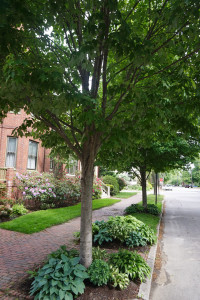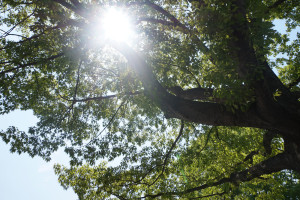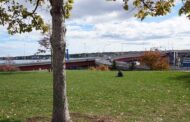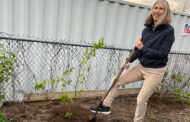
Hug a Tree! And Then Plant One
By Caitlin Marshall

As spring comes fully into bloom, trees all over the city are bursting into flower and leaf. They’re filling up with more and more song as migrating birds come back and host hundreds of varieties of caterpillars to feed those birds.
Trees & Climate Resilience
Trees are beautiful, and they’re marvelous habitats. Did you know that they are amazing players in climate resilience, too? First, of course, they breathe in what we breathe out. Trees soak up tons of CO2 every day, helping to offset emissions from cars and other carbon sources. They filter other pollutants out of the air, too.
Also, trees excel at buffering extremes in wind and water with their broad, leafy canopies. A row of street trees will soak up thousands of gallons of water that would otherwise flood city streets. They even have a measurable impact on temperature. Their shade reduces the need for cooling nearby buildings, and they can directly lower the temperature of surrounding areas by as much as 3° F. Increasing tree cover in our city will help us weather the growing extremes of a climate-changed world.
So, how do we get more trees?

Well, the first step is preserving what we already have! Old trees provide all these benefits better than young trees. But if you have the space to plant a new tree, there are plenty of options! For the greatest benefits in resilience and habitat, choose a species native to the Northeast. Smaller trees like beach plum, redbud, dogwood, cherry, and serviceberry can easily tuck into urban spaces. The West End Neighborhood Association has many resources as part of its ReForest the City initiative.
As we look to trees to build climate resilience, we need to support them, too. Many trees are falling prey to insects and diseases that have arrived from other places, and to which they have evolved little to no immunity. Ash Protection Collaboration Across Wabanaki (APCAW) is leading the effort to create a community-based response to the Emerald Ash Borer. The State of Maine has good resources on addressing Hemlock Woolly Adelgid. These disruptions are bound to reshape our forested landscape, but by working together, we can respond and find ways to bring more tree diversity into our cities, too.
So next time you head outside, hug a tree, and thank it for the myriad ways it makes our lives better. Then consider planting a few more.




